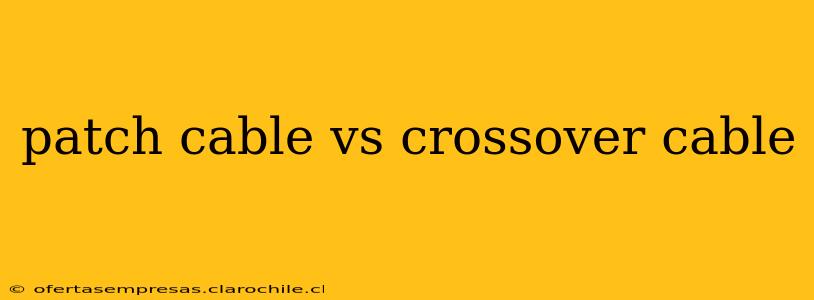Choosing between a patch cable and a crossover cable might seem like a minor detail, but it's crucial for ensuring your network devices communicate correctly. A simple mistake can lead to frustrating connection problems. This guide clarifies the differences between these two types of cables, helping you select the right one for your networking needs.
What is a Patch Cable?
A patch cable, also known as a straight-through cable, is the most common type of Ethernet cable. It connects devices of different types, such as a computer to a router, a switch to a modem, or a computer to a switch. The wiring inside a patch cable is arranged in a straight-through manner, meaning pin 1 on one end connects to pin 1 on the other end, pin 2 to pin 2, and so on. This configuration is essential because different network devices use different communication protocols, requiring a direct connection.
Key Features of a Patch Cable:
- Straight-through wiring: Pins are connected directly from one end to the other.
- Used for connecting dissimilar devices: Computer to router, switch to modem, etc.
- Most common Ethernet cable type: Found in virtually every network setup.
What is a Crossover Cable?
A crossover cable is designed to connect two similar network devices directly. This means connecting two computers, two switches, or two routers together without an intermediary device like a hub or switch. The key difference lies in its internal wiring; a crossover cable reverses the transmit (TX) and receive (RX) pairs. This crucial reversal allows the devices to communicate effectively without conflicting signals.
Key Features of a Crossover Cable:
- Reversed wiring: TX and RX pairs are swapped.
- Used for connecting similar devices: Computer to computer, switch to switch, etc. (Less common now with auto-MDIX)
- Less frequently needed due to auto-MDIX: Modern networking devices often handle the crossover automatically.
When to Use a Crossover Cable (and When You Probably Don't Need One)
Historically, crossover cables were essential for directly connecting two similar network devices. However, the advent of Auto-MDIX (Automatic Medium-Dependent Interface Crossover) has significantly reduced their necessity. Most modern network interface cards (NICs) and networking devices feature Auto-MDIX, automatically detecting the cable type and adjusting the connection accordingly. This means that in most cases, a standard patch cable will work perfectly for connecting two similar devices.
Situations where a crossover cable might still be relevant:
- Very old networking equipment: Older devices may lack Auto-MDIX capabilities.
- Specific industrial or specialized applications: Some legacy systems or industrial networks might still require crossover cables.
- Troubleshooting: In rare troubleshooting scenarios, using a crossover cable can help isolate network issues.
How to Tell the Difference Between a Patch Cable and a Crossover Cable?
Visually distinguishing between a patch cable and a crossover cable is generally impossible without specialized equipment. The internal wiring is the only true difference. Relying on visual cues is unreliable.
What is Auto-MDIX?
What is Auto-MDIX?
Auto-MDIX (Automatic Medium-Dependent Interface Crossover) is a feature built into most modern network interface cards (NICs) and networking equipment like switches and routers. It automatically detects whether a straight-through or crossover cable is connected and configures the connection accordingly. This eliminates the need for users to manually select the correct cable type.
Are Crossover Cables Obsolete?
While crossover cables aren't entirely obsolete, their use has drastically decreased due to Auto-MDIX. In most home and small office networks, a patch cable will suffice for virtually any connection.
Conclusion
Understanding the difference between patch cables and crossover cables is important for networking. However, thanks to Auto-MDIX, the need for crossover cables is significantly diminished. In most situations, a standard patch cable will work flawlessly. If you encounter connectivity issues, ensure your devices support Auto-MDIX, and consider troubleshooting other aspects of your network setup before assuming you need a crossover cable.
